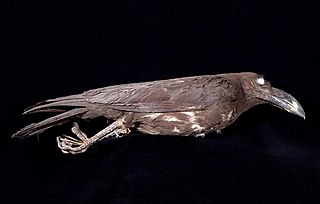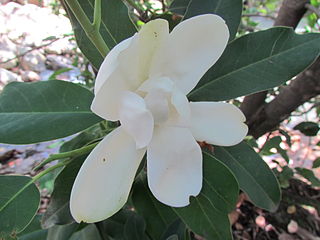
The bongo is a large, mostly nocturnal, forest-dwelling antelope, native to sub-Saharan Africa. Bongos are characterised by a striking reddish-brown coat, black and white markings, white-yellow stripes, and long slightly spiralled horns. It is the only tragelaphid in which both sexes have horns. Bongos have a complex social interaction and are found in African dense forest mosaics. They are the third-largest antelope in the world.

The Moluccan woodcock, also known as the Obi woodcock, is a lowland wader endemic to Indonesia. Its distribution is restricted to Obi and possibly Bacan, two small islands in North Maluku. It is a medium-sized bird, measuring 32-40 centimetres, and is the largest of the woodcocks. Its conservation status is vulnerable due to severe habitat destruction on Obi.

Lemurophoenix halleuxii is a species of palm tree, the only species in the genus Lemurophoenix. It is found only in Madagascar. It is threatened by habitat loss and overcollection. There are perhaps 300 mature individuals remaining in the wild.

The brown-headed crow is a passerine bird of the genus Corvus in the family Corvidae. Endemic to Indonesia, it has a fragmented distribution in subtropical or tropical moist lowland forest and subtropical or tropical mangrove forest. It is threatened by habitat destruction and the IUCN has rated it as being "near-threatened".
Magnolia iltisiana is a species of plant in the family Magnoliaceae. It is endemic to Mexico. Common names include ahuatoso and yoloxochitl.
Magnolia yoroconte is a species of tree in the family Magnoliaceae. It is found in Guatemala, Belize and Honduras.

The Trans-Mexican Volcanic Belt pine–oak forests is a subtropical coniferous forest ecoregion of the Trans-Mexican Volcanic Belt of central Mexico.

Quercus iltisii is a species of oak tree native to western Mexico, where it is found in a small portion of Jalisco and Colima states.

Magnolia pacifica is a species of Magnolia from Jalisco and Nayarit states in western Mexico.

Magnolia sharpii is a tree species of Magnolia from Chiapas, Mexico. It grows in wet tropical habitats.

The Jalisco dry forests is a tropical dry broadleaf forest ecoregion in southwestern Mexico.
Magnolia pugana, commonly known as almacasusco, is a species of Magnolia from northern Jalisco and southern Zacatecas states in western Mexico.
Magnolia krusei is a species of plant in the family Magnoliaceae. It is endemic to Mexico.
Magnolia nuevoleonensis is a species of flowering plant in the family Magnoliaceae. It is native to the Sierra Madre Oriental of Nuevo León state in northeastern Mexico.
Magnolia rzedowskiana is a species of flowering plant in the family Magnoliaceae. It is native to the Sierra Madre Oriental of San Luis Potosí, Querétaro, and Hidalgo states in eastern Mexico.
Magnolia vovidesii is a species of flowering plant in the family Magnoliaceae. It is native to the Sierra Madre Oriental of Veracruz state in eastern Mexico.
Magnolia faustinomirandae is a species of tree endemic to the Chiapas Highlands of Chiapas, Mexico.
Magnolia pedrazae is a species of flowering plant in the family Magnoliaceae. It is endemic to the Sierra Madre Oriental of eastern Mexico.
Magnolia guerrerensis is a species of flowering plant in the family Magnoliaceae. It is endemic to the Sierra Madre del Sur of Guerrero state in southern Mexico.
Magnolia oaxacensis is a species of flowering plant in the family Magnoliaceae. It is endemic to the Sierra Madre de Oaxaca of Oaxaca state in southern Mexico.










